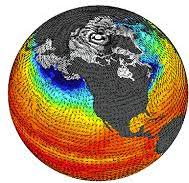 In an unprecedented collaboration, eight national laboratories will apply supercomputing resources to a new climate study with the National Center for Atmospheric Research. The project, called Accelerated Climate Modeling for Energy, or ACME, is designed to accelerate the development and application of fully coupled, state-of-the-science Earth system models for scientific and energy applications. The plan is to exploit advanced software and new high performance computing machines as they become available.
In an unprecedented collaboration, eight national laboratories will apply supercomputing resources to a new climate study with the National Center for Atmospheric Research. The project, called Accelerated Climate Modeling for Energy, or ACME, is designed to accelerate the development and application of fully coupled, state-of-the-science Earth system models for scientific and energy applications. The plan is to exploit advanced software and new high performance computing machines as they become available.
The grand challenge simulations are not yet possible with current model and computing capabilities,” said David Bader, LLNL atmospheric scientist and chair of the ACME council. “But we developed a set of achievable experiments that make major advances toward answering the grand challenge questions using a modeling system, which we can construct to run on leading computing architectures over the next three years.”
The initial focus will be on three climate change science drivers and corresponding questions to be answered during the project’s initial phase:
- Water Cycle: How do the hydrological cycle and water resources interact with the climate system on local to global scales? How will more realistic portrayals of features important to the water cycle (resolution, clouds, aerosols, snowpack, river routing, land use) affect river flow and associated freshwater supplies at the watershed scale?
- Biogeochemistry: How do biogeochemical cycles interact with global climate change? How do carbon, nitrogen and phosphorus cycles regulate climate system feedbacks, and how sensitive are these feedbacks to model structural uncertainty?
- Cryosphere Systems: How do rapid changes in cryospheric systems, or areas of the earth where water exists as ice or snow, interact with the climate system? Could a dynamical instability in the Antarctic Ice Sheet be triggered within the next 40 years?
Over a planned 10-year span, the project aim is to conduct simulations and modeling on the most sophisticated HPC machines as they become available, i.e., 100-plus petaflop machines and eventually exascale supercomputers. The team initially will use U.S. Department of Energy Office of Science Leadership Computing Facilities at Oak Ridge and Argonne national laboratories.
More information can be found in the Accelerated Climate Modeling For Energy: Project Strategy and Initial Implementation Plan.
Sign up for our insideHPC Newsletter.




